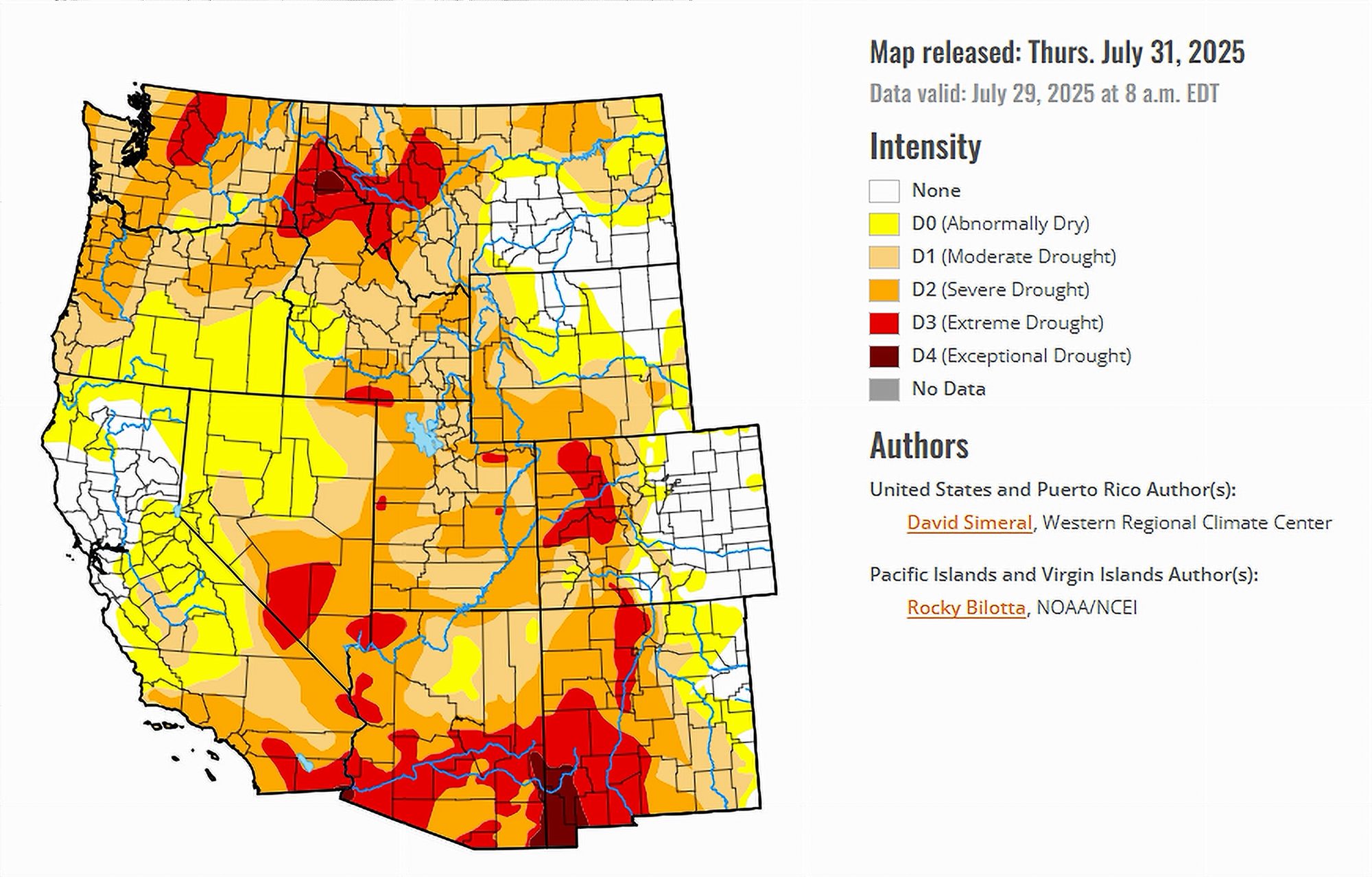- Drought improved in the Midwest, Plains, and parts of Texas.
- Conditions worsened across the Pacific Northwest and Intermountain West.
- California reservoirs remain above historical averages.
- Lake Mead and Lake Powell remain severely depleted.
Saturday, August 2, 2025 — As of July 31, 2025, the U.S. Drought Monitor reports a mixed bag across the country. Much of the Midwest, Plains, and southern Texas saw significant rainfall and corresponding improvements in drought classification. In contrast, the Pacific Northwest and portions of the Intermountain West—including Utah, Wyoming, and Colorado—continued to experience worsening conditions, particularly in waterways and soil moisture levels. According to the report, “the most significant rainfall accumulations were observed across areas of Kansas, Missouri, Iowa, and Minnesota, where they ranged from 3 to 7+ inches.”
Overall, the national map reflects both regional relief and persistent drought struggles. In the Southeast, pockets of dryness expanded, while isolated areas in Alabama, Georgia, and South Carolina slipped into Moderate Drought (D1) due to short-term rainfall deficits. The West presented a more worrying picture, with expanding dryness and concerning trends in surface water resources.
Spotlight on the Colorado River Basin.
Arizona and New Mexico: A Tale of Two Trends.
In Arizona, many streams and rivers, especially in the central part of the state, continue to exhibit poor surface water conditions. However, eastern New Mexico benefited from monsoonal activity that brought modest relief. The report noted that “monsoonal storms have provided some minor relief to areas experiencing long-term drought” in New Mexico. Still, long-term deficits remain an issue across much of the region.
California: Reservoirs Hold Strong—for Now.
California’s drought picture is more optimistic, at least for the time being. Major reservoirs in the state were performing well as of July 29. “California’s major reservoirs continue to be at or above historical averages for the date,” the report stated. Lake Shasta stood at 105% of average capacity, while Lake Oroville was even higher at 116%. These numbers reflect consistent rainfall earlier in the year, though upcoming forecasts predict dry and warmer conditions that could reverse the trend.
Colorado, Utah, and Wyoming: Worsening Dryness.
The Intermountain West faced setbacks this week. Drought conditions deteriorated across much of Colorado, Utah, and Wyoming, where “poor surface water conditions were present in many streams and rivers.” Although some isolated rainfall occurred in eastern Colorado and northeastern New Mexico, it was not enough to offset longer-term dryness. Western Wyoming, in particular, is showing troubling signs of streamflow deficits and low soil moisture.
Nevada: A Quiet Week Amid Regional Struggles.
Although specific drought category changes were not highlighted for Nevada this week, neighboring states saw enough change to indicate ongoing stress throughout the region. Much of the state remains vulnerable to shifting precipitation and reservoir levels as temperatures rise.
Reservoir Snapshot: Lake Mead and Lake Powell.
While California’s reservoirs look healthy, the two most critical water bodies for the Southwest—Lake Mead and Lake Powell—continue to reflect the longer-term drought. As of July 27:
-
Lake Powell was at 32% full, or 46% of average.
-
Lake Mead sat at 31% full, or 51% of average.
-
The total Colorado River system stood at 39% of capacity, a drop from 44% this time last year.
This year-over-year decline is troubling, especially as demand remains high and inflows remain unpredictable.
Looking Ahead.
According to the National Weather Service’s 7-day precipitation forecast, much of the western United States can expect dry conditions, with only scattered showers in the Rockies and mountain areas of New Mexico. The Climate Prediction Center’s outlook calls for above-normal temperatures across the Desert Southwest and southeastern Intermountain West—conditions that typically worsen drought severity. At the same time, below-normal precipitation is expected across much of the southern half of the West, Texas, and the southern Plains.
With temperatures rising and limited rainfall on the horizon, the Colorado River Basin will continue to face significant water management challenges. While parts of the region have seen localized improvement, the long-term outlook remains precarious.


